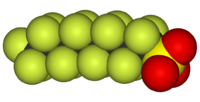
Photo from wikipedia
With the growing concern regarding the health risks of per- and polyfluoroalkyl substances (PFAS), there is an increasing demand for the identification of emerging PFAS. This study provides a comprehensive… Click to show full abstract
With the growing concern regarding the health risks of per- and polyfluoroalkyl substances (PFAS), there is an increasing demand for the identification of emerging PFAS. This study provides a comprehensive investigation of legacy and emerging PFAS in 16 wastewater treatment plants (WWTPs) in Belgium using target, suspect, and non-target screening methods. Perfluorobutanoic acid (PFBA) and perfluoropentanoic acid (PFPeA) were the dominant compounds in most locations, whereas perfluorooctanoic acid (PFOA) was the most predominant PFAS in WWTP Deurne (Antwerp region). Using a suspect screening approach, 14 PFAS were annotated as confidence level (CL) of 4 or higher and 4 PFAS were annotated as CL 2a and 2b, including aqueous film forming foam (AFFF)-derived PFAS. The compound group of n:3 unsaturated fluorotelomer carboxylic acid was found using non-target screening in the wastewater from WWTP Deurne. Population exposure in a catchment area estimated using population-normalized mass loads (PNML) showed the highest value in the catchment area of WWTP Deurne, implying a potentially higher exposure to PFAS in this community.
Journal Title: Journal of hazardous materials
Year Published: 2022
Link to full text (if available)
Share on Social Media: Sign Up to like & get
recommendations!